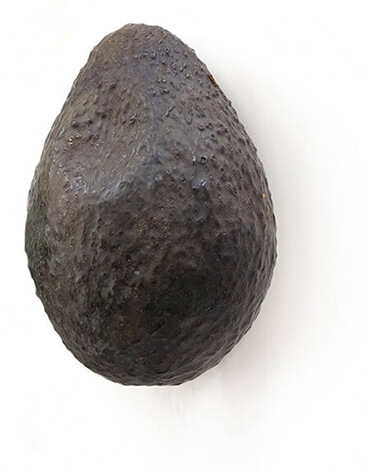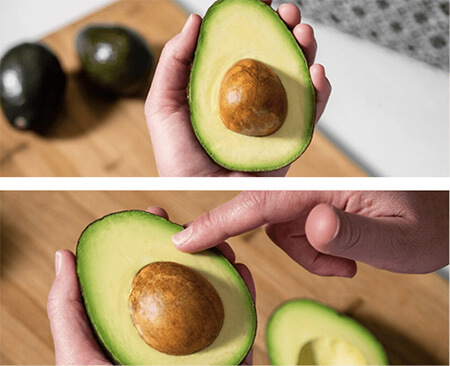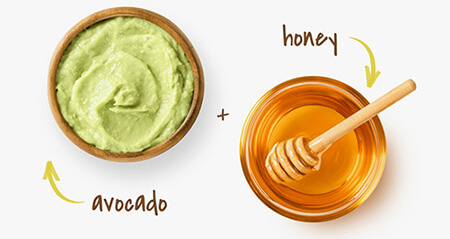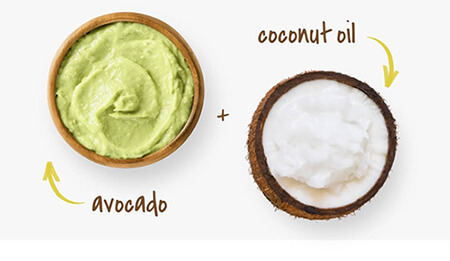How to Tell If an Avocado Is Overripe
An avocado is likely overripe if it’s very dark, mushy, or smells sour. Here’s how to tell:
On the outside:
- Excessively dark skin, especially near the stem.
- Dull or wrinkled skin.
- Sunken spots or deep indentations that feel overly soft.
- Mold near the stem or on the skin.
On the inside:
- Brown, gray, or black flesh, or discolored patches inside.
- Stringy or fibrous texture that feels slimy or mushy.
- Sour, rancid, or fermented smell, even if it looks okay.
- Visible mold or a chemical-like odor.
If the flesh is slightly brown but still smells fresh and isn’t slimy, you can cut away discolored areas and use the rest in smoothies, dressings, or baked goods.

How To Tell If an Avocado Is Overripe
(and What To Do About It)
When you’re looking forward to making a fresh guacamole or BLAT sandwich, you need to be sure your avocados are perfectly ripe. Knowing how to spot an overripe avocado can help you avoid waste, save money, and still make the most of your fruit — whether that means salvaging it for a smoothie or tossing it altogether.
In this guide, we’ll break down the key signs of overripeness so you can tell at a glance whether your avocado is past its prime. From the outside appearance to the texture and smell, here’s what to look for.
Signs Your Avocado Is Overripe
Before you slice into your avocado, there are a few clear signs on the outside that can tell you whether it’s past its prime. Start by checking for these clues.
Visual Signs
Overripe avocados tend to look darker than usual, often turning completely black. The skin may also appear dull instead of glossy. Check for large, sunken spots or deep indentations, which are indicators of internal bruising or decay. If you notice mold growing on the outer skin or around the stem area, it’s a clear sign that the fruit has spoiled, and you should not eat it.
While avocado colors may vary, most avocados start green and ripen into a darker hue. Most ripe avocados will typically be a deep green or almost black color. Its skin will typically have a smooth, taut skin with a slightly bumpy or pebbled texture.
01
Firmness Test
A ripe avocado should give slightly when gently squeezed, but an overripe one will feel mushy or overly soft. If it collapses under pressure or feels watery, that’s a strong indicator it’s gone past its peak. Once cut open, the flesh may appear stringy, slimy, or too soft to hold its shape, making it unsuitable for most recipes that call for fresh, firm avocados.
On the other hand, a ripe avocado should yield slightly to a gentle but firm squeeze without feeling overly soft or mushy.
02
Smell Test
Fresh avocados have a subtle, nutty scent and flavor. If yours smells sour, fermented, or has a chemical-like odor, it’s no longer safe to eat. A rancid smell typically signals oxidation or spoilage, even if the fruit looks fine from the outside. Always trust your nose — it’s one of the most reliable ways to assess freshness.
03
What Does an Overripe Avocado Look Like Inside?
Once you cut into an avocado, it’s easier to tell whether it’s too far gone. Overripe avocados often have brown or grayish flesh and may show black spots or bruises throughout. The texture can be fibrous or stringy, especially near the stem end.
A perfectly ripe avocado should have creamy, pale green to light yellowish flesh. Its texture will be smooth and creamy. Don’t panic if you see a few light brown spots — these are common and usually harmless. As long as the rest of the flesh smells fresh and isn’t slimy, you can cut around the discolored areas and still use what’s salvageable.

Signs Your Avocado Is Overripe
Before you slice into your avocado, there are a few clear signs on the outside that can tell you whether it’s past its prime. Start by checking for these clues.
Can You Still Eat an Overripe Avocado?
No, you generally shouldn’t eat overripe avocados.
We don’t recommend eating overripe avocados, as the line between safely overripe and completely spoiled, “likely to make you sick”, is too thin. If your avocado is brown, slimy, mushy, or grayish in color, it’s safest not to eat it.
When To Toss It
You should discard an avocado if you see mold, detect a sour or rotten smell, or notice a slimy or sticky texture. These signs indicate that the fruit has spoiled and is no longer safe to eat.
If the majority of the avocado is brown and mushy, while it may be technically safe to eat, it may not taste great.
What To Do With Overripe Avocados
Even when an avocado is too soft for slicing or topping toast, it doesn’t have to go to waste. If it’s too far gone for the kitchen but not moldy or spoiled, consider using it in a DIY face or hair mask—avocados contain nourishing oils that may benefit your skin and hair. You can mix the avocado with ingredients like honey, apple cider vinegar, or ground oats for a soothing at-home spa experience.
Avocado Honey Face Mask

Ingredients:
1 overripe avocado + 1 tbsp. honey
Directions:
Mash the overripe avocado up into a creamy pulp in a bowl. Add the honey and stir until it turns into a paste. Apply the mask to your face and neck. Leave on for 10-15 minutes for best results. Rinse off with warm water and pat dry.
Easy Avocado Hair Mask

Ingredients:
1 overripe avocado + 2-3 tbsp. coconut oil
Directions:
Mash up your overripe avocado in a bowl. Stir in coconut oil until well blended. Apply to hair starting at tips and working up to scalp. Allow to set for 5 minutes and then rinse thoroughly.
Tips for Buying and Storing Ripe Avocados
Avocados ripen quickly once they’re in the breaking ripening stage, so proper storage and smart shopping are key to keeping them fresh.
How To Pick The Right Avocado At The Store
Preventing overripe avocados starts at the grocery store. Select avocados based on when you plan to eat them: dark green/black and slightly soft for the same day, slightly firm and beginning to soften for a few days from purchasing day, and bright green/firm for longer-term ripening.
Buy a mix of ripeness levels and refrigerate ripe avocados to prolong freshness.
How To Store Avocados
To extend their shelf life, store ripe avocados in the refrigerator. This slows the ripening process and gives you a few extra days to use them.
If you’ve cut one open, brush the flesh with lemon or lime juice and store it in an airtight container to reduce browning and oxidation.
You’re now empowered to make the most of every avocado. You’ve learned how to identify signs of overripeness and what to do when you find one. With this knowledge, you can reduce waste and keep your meals flavorful.
Looking for creative ways to use up your ripe or slightly overripe avocados before they go bad?
Explore our collection of avocado recipes on Love One Today. From creamy smoothies and flavorful dressings to baked goods and satisfying meals, there’s always a great way to enjoy the full nutritional benefits of avocados while reducing waste in your kitchen.




